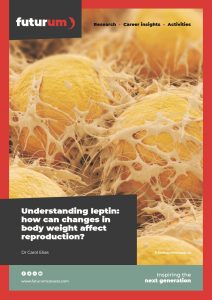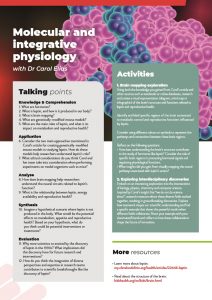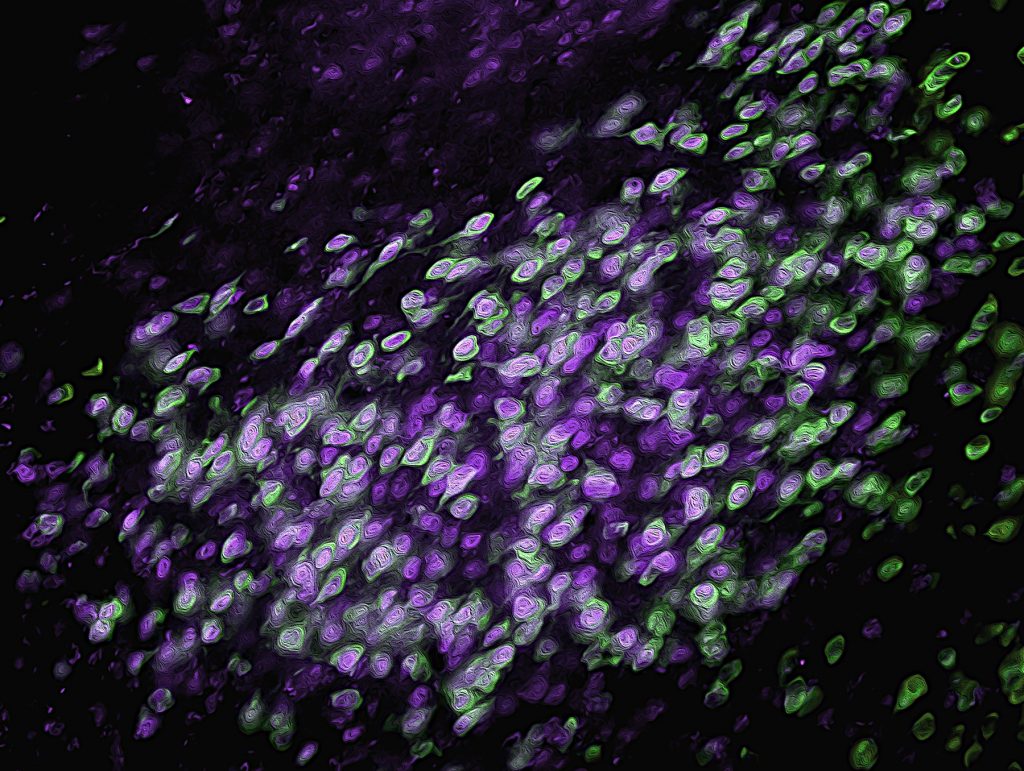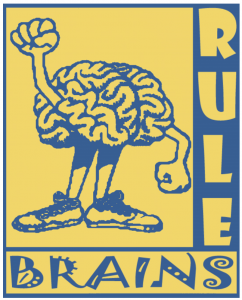Understanding leptin: how can changes in body weight affect reproduction?
Dr Carol Elias, a physiologist and neuroscientist at the University of Michigan Medical School in the US, is exploring how a hormone called leptin influences metabolism and reproductive health. She is seeking to uncover the mysteries behind conditions such as obesity, diabetes and infertility.
Talk like a physiologist
Comorbidity — the existence of two or more related diseases
Leptin — a hormone produced by our body’s fat, regulating energy expenditure, heat production, appetite and sexual maturation
Metabolism — the body’s chemical process (happening in all our cells) of converting food into energy
Neural circuits — interconnected networks of neurons, the basic building blocks of the nervous system
Neuroendocrine — related to the release of hormones in the bloodstream
Physiological processes — the activities and functions that occur within living organisms to maintain life (e.g., metabolism, reproduction and digestion)
Puberty — the stage of development during which a person’s body undergoes physical and hormonal changes, leading to sexual maturity and the ability to reproduce
Reproductive health — the state of complete physical and mental well-being in all matters related to the reproductive system, including its functions and processes, throughout the life cycle
In the intricate symphony of our bodies, hormones take centre stage, regulating various physiological processes. These chemical substances act like messengers; after being made in one part of the body, they travel to other parts of the body where they help control how cells and organs perform their functions. Their influence can be of great significance, regulating everything from our metabolism to our reproductive health.
Among these remarkable molecules, leptin emerges as a key player, acting as a communicator between our body’s fat cells and vital organs. When the delicate balance of this hormonal communication is disrupted, such as in conditions like obesity, it can affect how our body handles both metabolism and reproductive health. Dr Carol Elias, a physiologist at the University of Michigan Medical School, is using a variety of molecular methods, such as genetics, to explore the neural basis of leptin action and its influence on metabolism and reproductive health.
A little bit about leptin
“Leptin is a hormone produced by our body’s fat, or white adipose tissue,” explains Carol. “It is secreted into the body’s blood circulation and reaches organs and tissues where receptors are located.” These receptors act as molecular ‘docking stations’, waiting for leptin’s arrival to relay crucial messages. Once leptin attaches to its receptors, it sends signals which lead to regulated responses in the body. These responses affect metabolism, appetite and reproductive health. “Leptin has many different roles related to energy expenditure, heat production, appetite and sexual maturation, among others,” explains Carol.
The diverse roles of leptin explain why its discovery was met with such enthusiasm. “The discovery of leptin in the 1990s was a significant moment for scientists in our field because it brought new possibilities to understand the cause and development of obesity, diabetes and diseases related to both, what we call ‘comorbidities’,” says Carol. “I was a neuroscience student at the University of São Paulo in Brazil at that time, and the excitement was huge because it turned out that the main site of leptin action is the brain.” This discovery marked a turning point in scientific exploration, revealing the neural circuits that control energy balance and reproductive functions.
How can we study leptin?
Investigating the function of leptin involves combining laboratory techniques and genetic manipulation. More specifically, Carol and her team employ genetically-modified mouse models (mice that have been altered at the genetic level) to reveal the complexities of leptin’s role.
These models can be created through two main approaches. The first method involves modifying a known or suspected disease-causing gene based on existing research findings. “If this gene is also found in mice, we can make modifications in this gene in the mouse and study the development of the disease and how we can treat it,” explains Carol. “The other method is the inverse path, i.e., we make changes in a gene we do not know the function of and investigate what this modification results in for the mouse.” If a disease occurs, this information is then used by other scientists to investigate whether a similar gene mutation is observed in humans with a comparable condition. Carol’s research focuses on factors associated with infertility, obesity and diabetes. By modifying specific genes, Carol and her team can observe the resulting physiological changes in the mice, offering valuable information about leptin’s function.
Brain mapping is a set of neuroscience techniques used to create a map of the brain’s structure and functions. This can involve identifying and understanding different regions of the brain and how they are connected, as well as determining the specific tasks or activities each region is responsible for. “To understand how the neurons are connected and how these connections generate a specific response related to hormone secretion or behaviour, we use what are called neuronal tracers,” says Carol. “These are molecules that enter the neurons and are transported through the axons (nerve fibres) to the terminals (where one neuron communicates with another via synapses).” By injecting neuronal tracers into specific areas of the brain and then examining their distribution using specialised tools, researchers can get important information about the brain’s intricate wiring. “Using this approach, we have learnt that many parts of the brain are connected in the metabolic control of reproduction,” explains Carol.
How does leptin connect energy to puberty and fertility?
“Our studies showed that leptin is one of the main hormones that signals energy availability to the brain,” says Carol. This communication plays a dual role: guiding the path of pubertal development and influencing the balance between energy storage, weight and fertility. “If not enough energy is available, the organism has a way to block reproduction,” explains Carol. “On the other hand, an excess of energy (i.e., obesity) may also decrease fertility because high levels of circulating hormones produced by the adipose tissue (e.g., leptin) may result in resistance, where cells fail to respond.” This highlights the intriguing link between metabolic health and reproductive health and emphasises the importance of hormonal balance for optimal fertility.
What has Carol’s team discovered?
Researching which parts of the brain connect metabolism and reproduction, Carol’s team has already discovered specific groups of neurons that can detect leptin and respond to control the neuroendocrine reproductive function.
Carol’s next steps include exploring the role of sex hormones, particularly testosterone, in the regulation of metabolism, and investigating the effect of childhood obesity in brain development and how it might shape the neuroendocrine response in adult life. These initiatives represent a frontier of discovery, set to reveal crucial insights into the complexity of hormonal regulation, metabolic pathways and reproductive functions.
Reference
https://doi.org/10.33424/FUTURUM475
All photos: Carol Elias

Dr Carol Elias
Department of Molecular & Integrative Physiology, University of Michigan Medical School, Michigan Medicine, USA
Fields of research: Neuroendocrinology, metabolism, obesity, diabetes, infertility
Research project: Investigating the neural basis of leptin action in reproduction
Funder: US National Institutes of Health (NIH)
About molecular and integrative physiology
Molecular and integrative physiology focuses on understanding how the molecular mechanisms within living organisms contribute to their overall function and how these mechanisms integrate at various levels to maintain health or respond to challenges. “Basically, the field focuses on how the body works and what happens when things go wrong causing a disease,” says Carol.
The research within this field spans diverse areas such as cardiovascular (related to the heart and blood vessels), renal (kidneys) and gastrointestinal (stomach and intestine) physiology, as well as neuroscience. “My lab focuses on the brain and the neural circuitry and molecular pathways that connect metabolism and the neuroendocrine system,” explains Carol.
This dynamic field reveals the complexities of cellular processes and their integration into the larger physiological context allowing you to learn something new every day. “Research in my field is very rewarding because we learn a new lesson on how the brain works every day,” says Carol. Looking forward, the next generation of neuroscientists will find a variety of research opportunities available to them. “The last decade has seen an enormous development in neuroscience, mostly due to the development of new technologies,” explains Carol. From the use of computational models to bioinformatics and machine learning, these technological advancements not only provide useful information about the brain but also present novel avenues for exploration and discovery.
Pathway from school to molecular and integrative physiology
“I believe students in all scientific fields will need a good training in coding, programming, computational modelling and ‘best practices’ for the use of artificial intelligence,” says Carol.
To prepare for a career in physiology, it would be beneficial for high school students to take a combination of science and computational courses (such as biology, chemistry, mathematics, programming and computer science).
At university, pursuing a bachelor’s degree in physiology, neuroscience or biochemistry is an excellent starting point.
Identify researchers in the field of physiology, especially those whose work aligns with your interests. Visit their university websites and explore opportunities of internships and lab experience.
Explore careers in molecular and integrative physiology
Carol recommends exploring websites such as the Society for Neuroscience, the Endocrine Society, and the American Physiological Society.
“The University of Michigan offers many wonderful opportunities for students to learn about science and careers in science,” says Carol. “For example, undergraduate opportunities, the Centre for Educational Outreach, Science Engagement and Education for Kids (SEEK), the Neuroscience Undergraduate Research Opportunity (NURO), and the Summer Intensive Research Experience in Neuroscience (SIREN).”
Meet Carol
I always liked learning about the human body, animals and nature. In college, my major was in biological sciences. During a physiology class, I learnt about the brain and how neurons are connected to generate behaviour or body function. I fell in love with studying the brain and learning more about its huge complexity and how it functions in health and diseases.
During college years, I worked as research assistant in the physiology and cell biology departments. The brain was always my passion, so I did my PhD in neuroscience. During my PhD, I worked on the microscopic anatomy of brain tissue and methods of labelling neurons with fluorescent markers. I used to spend hours on the microscope looking at neurons, their different morphology, dendrites and axons. A special moment came with the discovery of leptin. Until then, we did not know the adipose tissue worked as an endocrine gland and that its main target was the brain. This information fascinated me.
Every small achievement in my career has made me proud because each has been necessary to reach my goals. Two important achievements for me were being accepted for a postdoctoral fellowship at Harvard University and being hired by the University of Michigan. The first because it opened the doors for high level research, and the second because it meant a recognition of my potential as an independent researcher.
It is important to emphasise that we do not do science alone. My lab has been fortunate with exceptional students and fellows. Some, like Judney Cavalcante, Jose Donato Jr. and Renata Frazao, David Garcia-Galiano, and Xingfa Han, now lead their own productive research in Brazil, Spain and China, respectively. Additionally, Beatriz Borges, Cristina Saenz, Ally Cara and Bethany Beekly are young scientists in the initial steps of their careers. Mentors, collaborators and assistants have also been very important for the success of my research. Jackson Bittencourt (University of São Paulo), Cliff Saper (Harvard University), Joel Elmquist (University of Texas Southwestern Medical Center), Sue Moenter and Martin Myers (University of Michigan) and Susan Allen (my lab manager for 10 years) have all been fundamental to my career.
Currently, I am involved in two important projects. One is as director of the Neuroscience Graduate Program, to which I dedicate 40% of my time to ensure students are well trained and prepared for the next steps of their career. The second is as director of a national centre associated with the National Institutes of Health. It provides analysis of changes in metabolism of experimental mouse models used by laboratories around the country in studies of diabetes and obesity. The main goal of this centre is to improve access to state-of-the-art technology to researchers from underrepresented groups or from institutions without consistent and significant funding for research.
Carol’s top tips
1. Believe in yourself and be open to opportunities.
2. Go beyond your comfort zone.
3. Take some risks, be patient and prepare yourself for the next steps.
Do you have a question for Carol?
Write it in the comments box below and Carol will get back to you. (Remember, researchers are very busy people, so you may have to wait a few days.)















0 Comments